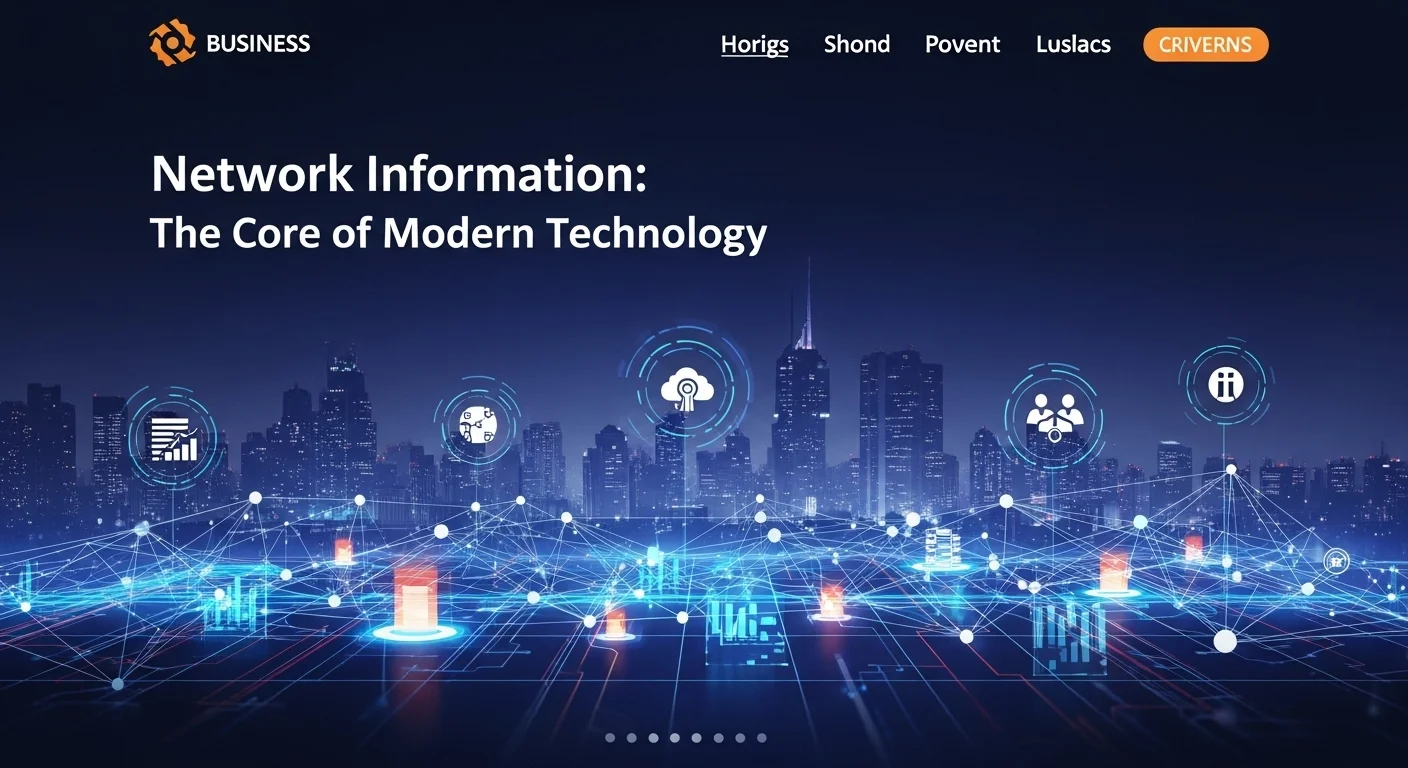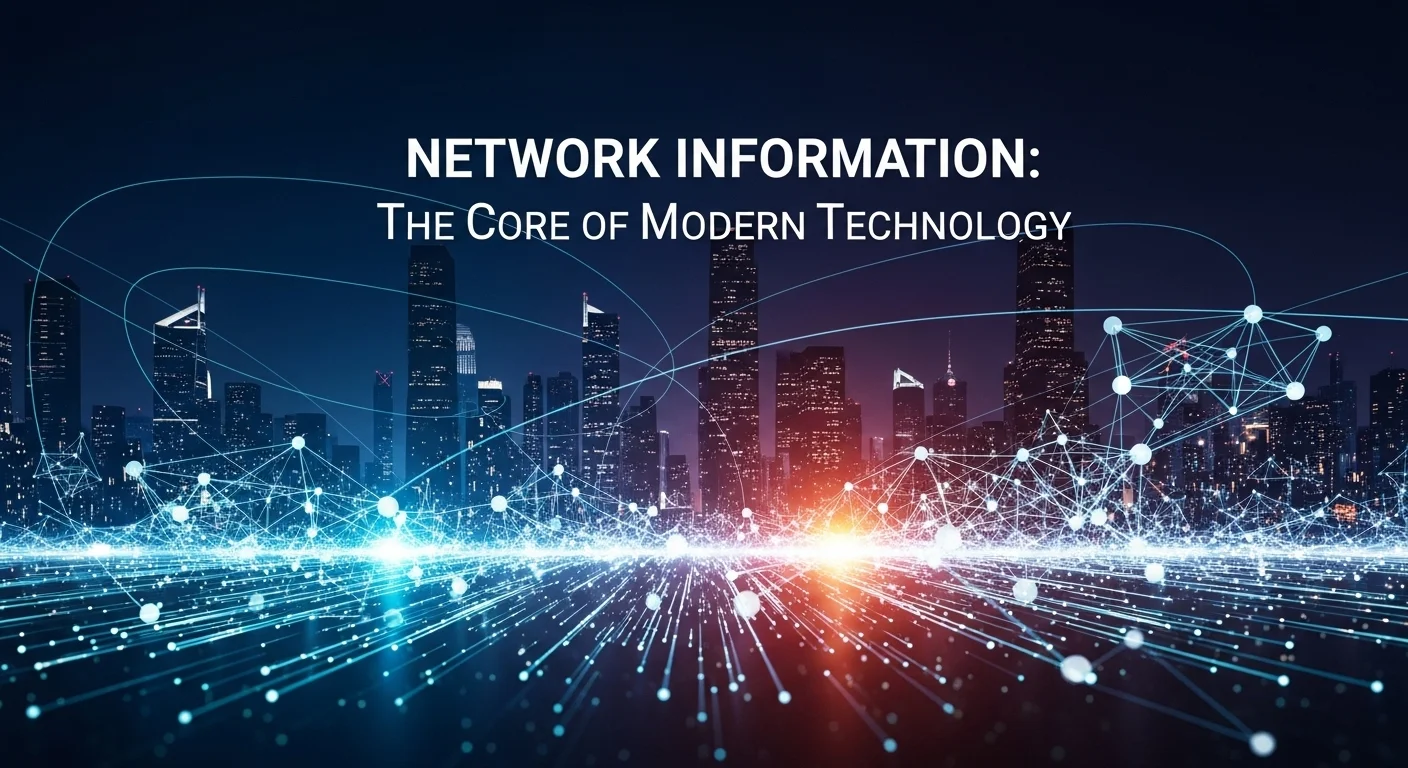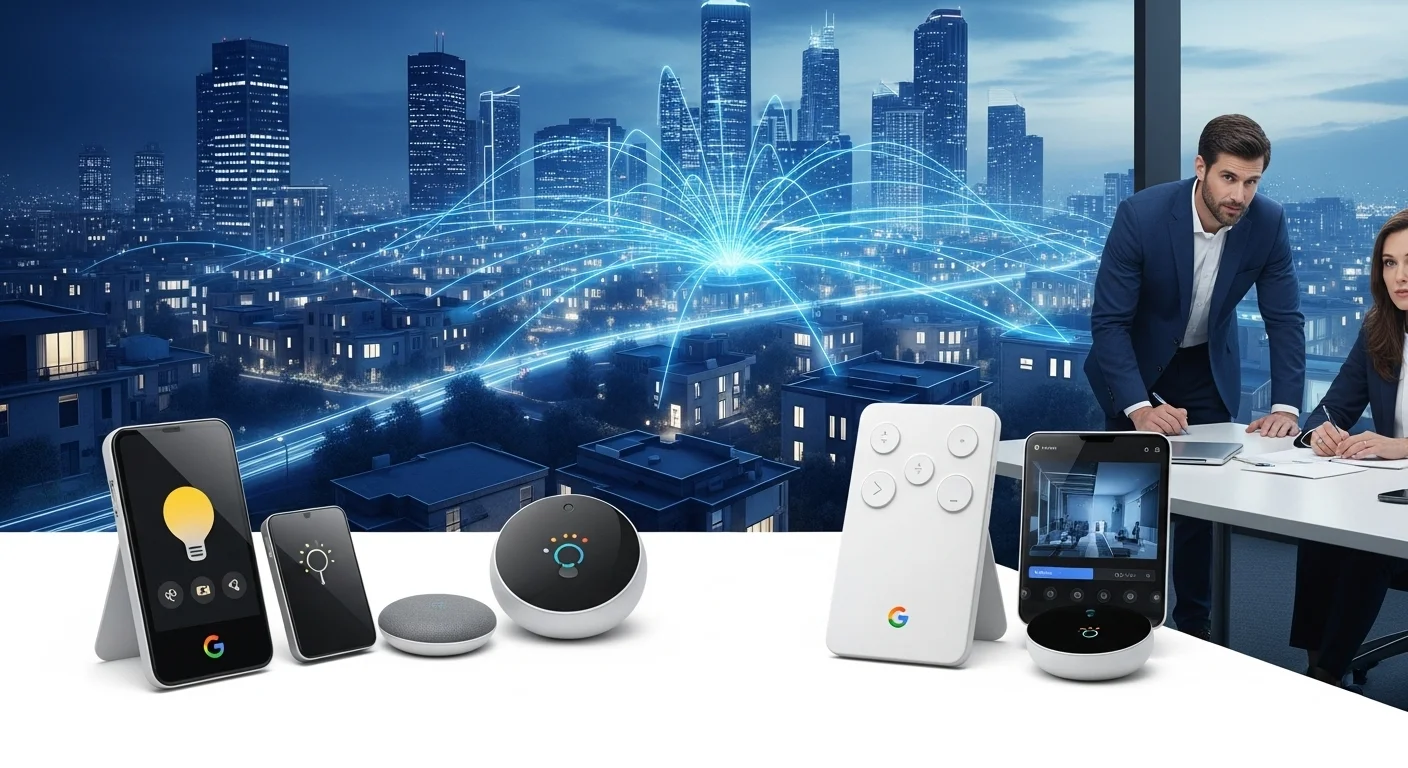Your Network is Talking: A Practical Guide to Network Information

Executive Summary
Think of your company's computer network as its central nervous system. It's constantly buzzing with signals—data that tells you everything about its health, performance, and security. But are you actually listening to what it's saying? This data, what we call 'Network Information,' is the key to not just fixing problems, but preventing them entirely. I've spent years in the trenches of IT, and I can tell you that understanding this information is the difference between an organization that's always putting out fires and one that's innovating and growing. This guide is my attempt to cut through the jargon and give you a straightforward look at what network information is, why it's a goldmine for your business, and how you can start using it to make smarter decisions, bolster your security, and build a truly resilient digital foundation.
Table of Contents
Table of Contents
What is Network Information and Why Is It So Important?
In our hyper-connected world, we talk a lot about networks, but we often forget about the lifeblood that flows through them: network information. Simply put, this is all the data that describes the health, behavior, and performance of your network at any given moment. It’s the collection of logs, metrics, and traffic data that, when you piece it all together, gives you a clear picture of what's happening inside your digital infrastructure. I've always seen it as the sensory system for technology. Without it, you’re essentially flying blind, trying to manage a complex system with no visibility. A computer network is just two or more devices connected to share resources, but getting them to communicate effectively and securely is where the real challenge lies. They follow rules, or 'protocols,' to talk to each other, forming everything from a simple two-computer setup to the entire internet.
The importance of this information is something I can't stress enough. Imagine being an air traffic controller but with your radar screens turned off. That's what running a network without proper information is like—it’s a recipe for chaos and disaster. Network information is what helps you spot digital traffic jams, identify system glitches before they cause an outage, and secure the pathways where your company's most critical data travels. It makes collaboration smoother and business more productive. For me, the conversation always comes back to security. Solid network and information security isn't built on expensive tools alone; it's built on the foundation of comprehensive network information. It's important to distinguish between information security and network security. Information security is about protecting the data itself, wherever it is. Network security is about protecting that data as it moves across your network—making network information its primary field of vision.
The Core Components of Network Information
Network information isn’t just one thing; it's a puzzle made of different types of data. Understanding these pieces is the first step to seeing the whole picture. Here are the main ones I work with every day:
- Flow Data: Think of this as a phone bill for your network. Instead of recording the entire conversation (the data packet), protocols like NetFlow or IPFIX create a summary: who talked to whom, for how long, and how much data was sent. It's incredibly efficient for understanding general traffic patterns, spotting bandwidth hogs, and detecting strange behavior without the massive storage needed for full packet capture.
- Packet Data (PCAP): This is the whole conversation. Full Packet Capture (PCAP) records every single bit of data crossing a point in your network. It's resource-heavy, for sure, but when you're troubleshooting a really tricky problem or doing a deep forensic analysis after a security breach, it's absolutely priceless. I've solved countless 'mystery' issues with a good Wireshark analysis of a PCAP file.
- Log Data: Your network devices—routers, firewalls, servers—are constantly writing in a diary. These logs record everything from login attempts and configuration changes to system errors and security alerts. Bringing all these logs into one place with a system like a SIEM (Security Information and Event Management) is a cornerstone of modern security. It lets you connect the dots between seemingly unrelated events.
- SNMP and Telemetry Data: Simple Network Management Protocol (SNMP) is the old workhorse of network monitoring. It lets you 'poll' devices and ask, 'How are you doing?' You can check CPU load, memory usage, and bandwidth. Modern streaming telemetry is the evolution of this, pushing this health data to you in real-time, giving you a much more immediate pulse on your network's health.
- Device and Topology Information: This is the blueprint of your network. It's the data about what devices you have, how they're physically and logically connected, and their current status. Having an accurate network map is fundamental for everything from planning upgrades to understanding the blast radius of a potential outage.
When you start combining these different data sources, you move from just collecting data to gaining true insight. This holistic view is the heart of effective network information security and proactive management.
Business Applications and Real-World Benefits
When you use network information smartly, it stops being an IT cost and starts becoming a driver of business value. Your network is the backbone of your operations, and keeping it healthy means keeping your business competitive.
- Performance Optimization and Capacity Planning: By seeing how your network is being used, you can fine-tune it for peak performance. I've helped businesses realize their critical cloud applications were slow simply because non-essential traffic was hogging bandwidth. Analyzing trends over time also means you can plan for the future, upgrading your infrastructure just before it becomes a bottleneck, saving money and preventing slowdowns.
- Enhanced Security Posture: For security, network information is everything. It allows you to establish a 'normal' baseline of activity. When something deviates from that baseline—like a laptop suddenly sending data to a suspicious country—you get an immediate red flag. This proactive threat hunting is a core principle of modern information security in network security. It’s how you catch threats before they do real damage.
- Faster Troubleshooting: When things break—and they always do—network information is your roadmap to the fix. I've seen teams spend days trying to solve an issue that a quick look at flow data or device logs could have pinpointed in minutes. Reducing that downtime (what we call Mean Time to Resolution) has a direct, positive impact on the bottom line.
- Compliance and Auditing: If your business operates in a regulated industry like finance or healthcare, you have to prove you're protecting data. Network information provides that proof. It's the auditable trail that shows who accessed what, when, and how. Agencies like the European Union Agency for Network and Information Security (ENISA) have built their frameworks around the idea that robust monitoring and logging are essential for compliance.
- Cost Reduction and Better Spending: Understanding resource usage helps you spend smarter. You might discover you're paying for a massive internet connection that's barely being used, or that you can consolidate servers. This data-driven approach ensures your technology budget is aligned directly with your business goals.
In the end, network information isn't just for techies. It's a strategic asset that provides the clarity you need to run a reliable, high-performing, and secure business. By harnessing this data, you can turn your network from a source of problems into a powerful engine for innovation and growth.

A Deeper Dive: Techniques, Strategy, and Tools for Network Information
Truly understanding network information means going beyond the 'what' and into the 'how.' It's about mastering the technical methods for gathering data, the business strategies that turn that data into an advantage, and the ecosystem of tools that make it all possible. This is where we move from theory to practice. In my experience, a company's ability to manage its network information directly reflects its ability to manage a core business function. It’s not just about IT maintenance; it's about building a resilient and agile enterprise ready for the future.
Technical Methods for Collection and Analysis
Getting high-quality network information is a craft. Each collection method gives you a different piece of the puzzle, and the best strategies I've seen always use a combination of these to get a full, 360-degree view.
- Simple Network Management Protocol (SNMP): This is the old reliable of network monitoring. It’s like taking the pulse of your devices. A central system 'polls' your routers, switches, and servers, asking for specific stats like bandwidth use, CPU load, and uptime. It’s fantastic for a high-level health check, but it won't tell you much about the actual content of the traffic.
- Flow-Based Monitoring (NetFlow, sFlow, IPFIX): If SNMP is the pulse, flow data is the traffic report. It summarizes network conversations, telling you who is talking to whom and what applications are being used. It's the perfect balance between detail and efficiency. I use it constantly to answer questions like, 'Why is the internet slow?' or 'Is there any unusual traffic leaving our network?' It's a cornerstone for practical network information security.
- Packet Capture and Analysis: When you need to see everything, you capture the packets. This is the most granular level of detail possible, like recording every word of every conversation. It’s overkill for 24/7 monitoring on busy networks because of the massive storage it requires, but for deep-dive troubleshooting or security forensics, it is the ultimate ground truth. There's no hiding from a packet capture.
- Log Aggregation and SIEM: Every device on your network is constantly generating logs—a running commentary of its activities. A Security Information and Event Management (SIEM) system is like a master detective that gathers all these logs, from firewalls to servers, into one place. It then correlates events to find the patterns that a human might miss, turning a mountain of noisy data into a clear signal of an attack. This is where information security in network security truly becomes a unified discipline.
- Active and Passive Monitoring: These are two different philosophies. Passive monitoring, like flow analysis, is about listening to the traffic that's already there. Active monitoring is about creating your own traffic to test the network. The simple 'ping' command is a basic form of active monitoring. More advanced tools can simulate a user logging into a web application to constantly measure performance from an end-user's perspective.
Business Techniques and Strategic Integration
Collecting data is just the start. The real magic happens when you weave that information into your business strategy. This is about shifting your perspective to see the network as a source of powerful business intelligence.
- Establishing Baselines and Anomaly Detection: The first and most critical step is to understand what 'normal' looks like on your network. Once you have a steady baseline, you can use modern tools, often with a bit of AI, to automatically flag anything that deviates. This is your early warning system, not just for security threats ('Why is this server suddenly sending out huge amounts of data at 3 AM?') but for performance issues too ('Why does application response time spike every afternoon?').
- Adopting a Zero Trust Architecture: The old idea of a secure internal network and a dangerous external one is long gone. The Zero Trust model works on a simple, powerful principle: 'never trust, always verify.' To do this, you need total visibility. You have to see every user and device, understand all the traffic, and enforce access policies based on that real-time information. Network information isn't just helpful for Zero Trust; it's the foundation it's built on.
- Regulatory Compliance and Reporting: For many businesses, proving you're compliant with regulations like GDPR or HIPAA is a constant pressure. Network information provides the hard evidence. You need to generate reports showing who accessed sensitive data, a log of all firewall changes, or proof that data is encrypted in transit. Organizations like the European Union Agency for Network and Information Security (ENISA) champion these practices, making them a de facto standard for responsible operations.
- Leveraging AI for IT Operations (AIOps): The amount of data a modern network produces is staggering—far too much for humans to analyze alone. This is where AIOps comes in. These platforms use AI and machine learning to sift through the noise, correlate events to find the patterns that a human might miss, turning a mountain of noisy data into a clear signal of an attack. An AIOps tool might see a subtle increase in disk errors and predict an impending server failure, giving you time to act before an outage occurs.
Resources and Comparisons
The market for network tools is huge, but they generally fall into a few categories. The right choice for you depends on your budget, team size, and specific needs.
- Open Source: Tools like Nagios, Zabbix, and Wireshark are incredibly powerful and free. The trade-off is that they require significant in-house expertise to set up and maintain. They're a great fit for teams that have the time and skill to build their own solutions.
- Commercial Vendors: Companies like SolarWinds, Datadog, and Splunk offer polished, all-in-one platforms. They are easier to use, come with professional support, and often combine logs, metrics, and flows into a single dashboard. They represent a faster path to getting actionable intelligence from your network data.
- Cloud-Native Tools: If you're heavily invested in a cloud platform like AWS, Azure, or Google Cloud, their built-in tools (CloudWatch, Azure Monitor, etc.) are powerful and deeply integrated. The challenge arises in hybrid environments, where a third-party tool is often needed to get a single view across both your cloud and on-premise infrastructure.
Ultimately, the goal of any tool is the same: to transform raw, chaotic data into clear, actionable intelligence. That intelligence is what allows you to build a secure, high-performance digital infrastructure where the principles of information security and network security are an everyday reality.

Actionable Tips for Mastering Network Information
Getting a handle on network information isn't just about buying software. It's about adopting smart strategies and building a culture where performance and security are everyone's responsibility. I've seen firsthand how moving from a reactive, 'fire-fighting' mode to a proactive, strategic approach can completely transform a business's technology experience. The goal is to build a resilient and secure environment where your people and your applications can do their best work. This is a continuous journey of assessing, improving, and educating.
Best Practices for Network Information Management
Over the years, I've found that a few core practices make all the difference. Nailing these fundamentals will vastly improve your ability to use network data effectively.
- 1. Conduct an Honest Network Audit: You can't protect what you don't know exists. The first step, always, is to map out your entire network. I've walked into so many businesses that were shocked to discover dozens of 'shadow IT' devices—unmanaged phones, servers, or IoT gadgets—plugged into their network, creating massive security holes. A thorough audit gives you the ground truth you need to build on.
- 2. Implement Network Segmentation: Don't run a flat network where everything can talk to everything else. Segmentation is about creating smaller, isolated zones. For example, your guest Wi-Fi should be completely separate from your internal corporate network, and your critical servers should be in their own protected segment. If one area is breached, segmentation acts like a firewall, preventing the attacker from spreading across your entire infrastructure. It's a foundational practice for solid network information security.
- 3. Enforce the Principle of Least Privilege: This is a simple but powerful idea: give users and systems the absolute minimum access they need to do their job, and no more. A user in marketing doesn't need access to finance servers. By strictly limiting privileges, you dramatically reduce the potential damage from a compromised account. It’s a core tenet of both information security and network security.
- 4. Encrypt Data Everywhere: Your data has two states: at rest (on a disk) and in transit (moving across the network). It needs to be encrypted in both. Using technologies like TLS for web traffic and WPA3 for Wi-Fi is non-negotiable. Encryption ensures that even if someone manages to intercept your data, it's just unreadable gibberish to them.
- 5. Keep Everything Patched: One of the easiest ways for attackers to get in is by exploiting known software bugs. Vendors constantly release patches to fix these vulnerabilities. Having a disciplined, consistent patch management process for your operating systems, applications, and network gear is one of the most effective security measures you can take.
- 6. Centralize Your Logs and Monitor Them: Having logs on a hundred different devices is useless. You need to pull them all into a central system, like a SIEM, where you can analyze them together. This is how you spot sophisticated attacks that touch multiple systems. The European Union Agency for Network and Information Security (ENISA) consistently highlights logging and monitoring as critical capabilities for any secure organization.
- 7. Develop and Test Your Incident Response Plan: It’s not a question of *if* you'll have a security incident, but *when*. You need a clear, written plan for what to do when it happens. Who makes decisions? How do you communicate? What are the technical steps to contain the threat? Just as importantly, you need to practice this plan with drills so that when a real crisis hits, everyone knows exactly what to do.
Tools and Experiences for Different Scales
The right tool depends on your organization's size, budget, and technical expertise.
- For Small Businesses: You don't need a million-dollar setup. Solutions like Ubiquiti's UniFi platform provide amazing visibility and control for a low cost. Cloud-managed firewalls from vendors like Meraki or Fortinet bring enterprise-grade security to teams without a deep security bench. For monitoring, free versions of tools like PRTG or Zabbix can be incredibly powerful.
- For Medium to Large Enterprises: At this scale, you need comprehensive platforms that can handle complexity. Tools like SolarWinds Network Performance Monitor are standards for deep performance analysis. For security, a SIEM like Splunk, Microsoft Sentinel, or IBM QRadar is essential for correlating data at scale. Increasingly, I'm seeing businesses adopt Network Detection and Response (NDR) tools from vendors like Darktrace or Vectra that use AI to find threats that other tools miss.
- For Cloud Environments: The cloud brings its own visibility challenges. You have to master the native tools like AWS CloudWatch or Azure Monitor. However, most businesses I work with are hybrid or multi-cloud, so they often turn to third-party platforms like Datadog or New Relic to get that crucial 'single pane of glass' view across all your environments, from the data center to the cloud.
A Trusted Resource and Final Thoughts
If you want to go deeper into cybersecurity frameworks and official best practices, I always recommend visiting the website for the European Union Agency for Network and Information Security (ENISA). They publish a wealth of high-quality reports and guidelines that are invaluable. You can find them at www.enisa.europa.eu.
To wrap it all up, network information is the foundation of a modern, resilient, and high-performing technology strategy. It’s the critical asset that gives you visibility into your digital world. By embracing these best practices, picking the right tools for your needs, and building a security-first culture, you can turn your network from a source of problems into a powerful engine for innovation and growth. The line between network and information security has blurred completely; today, protecting your network information is one of the most fundamental jobs of any business that wants to succeed.
Expert Reviews & Testimonials
Sarah Johnson, Business Owner ⭐⭐⭐⭐
As a small business owner, this was a great starting point. The idea of network segmentation was an eye-opener. I wish there were a few more budget-friendly tool suggestions, but overall, very helpful.
Mike Chen, IT Consultant ⭐⭐⭐⭐⭐
Solid overview. As an IT consultant, I appreciated the clear distinction between flow data and packet capture. It's a great resource to share with clients who need to understand the 'why' behind our recommendations.
Emma Davis, Tech Expert ⭐⭐⭐⭐⭐
Finally, an article that connects the deep tech with business strategy. The section on AIOps and Zero Trust was spot-on. This is one of the best, most comprehensive pieces I've read on network information.



